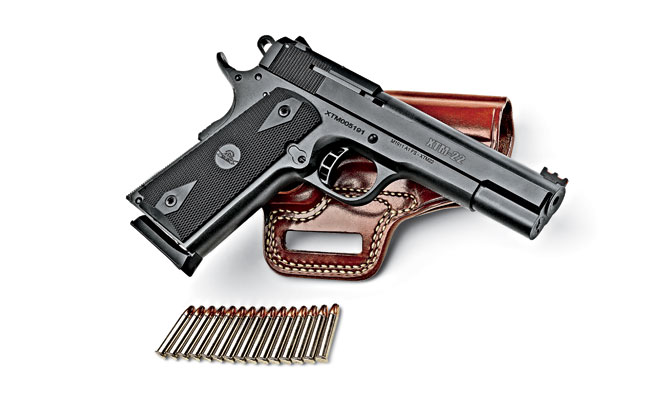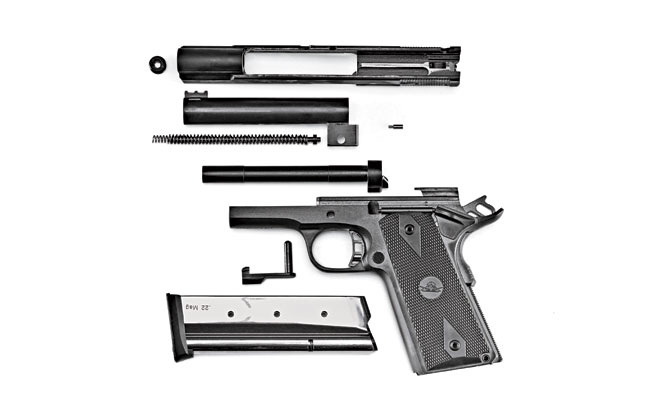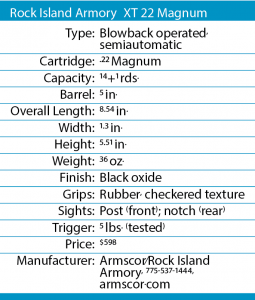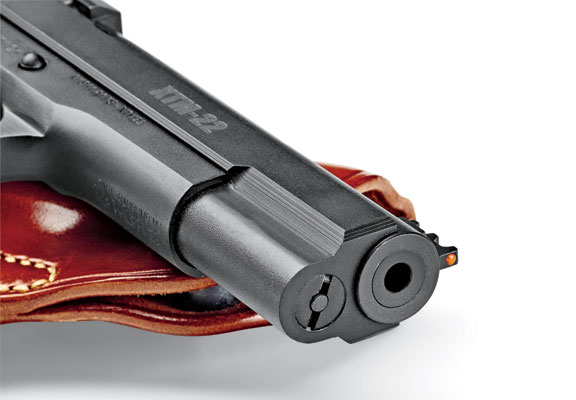
Rock Island Armory XT 22 Magnum
When it comes to firearms, we consider a lot of ratios. The cost-benefit ratio. The weight-to-power ratio. The size-to-magazine-capacity ratio. But how often do we consider the fun-to-size ratio? Or the utility-to-disadvantaged ratio? After spending some time with the new Rock Island Armory (RIA) XT 22 Magnum, I can conclude that it scores high in the last two and doesn’t neglect the others.
Chambered in .22 Magnum, the XT 22 is built on a single-stack, all-steel 1911 frame. Getting a 1911-based design to run on a magazine loaded with .22 Magnum cartridges is a notable achievement. But this is RIA, the same company that gave us the hot .22 TCM. G&A’s editors have been monitoring the development of this pistol for the last couple of years with our fingers crossed, and we’ve all been anxious for this announcement.

The big problem with rimfires is that they really don’t have the oomph to cycle the slide of a 1911, even if the slide is modified for blowback operation only. Yes, even the .22 Magnum lacks the muscle for slide cycling. It punches above its weight downrange, but we’ll get to that in good time.
 A Lean Machine Martin Tuason, president and CEO of RIA, and his team have solved the cycling challenge with two approaches. First, they reduced the slide mass by removing the top section. This removes the superfluous locking lugs, and also takes out the weight of the steel that would otherwise be forward of that area. This begged the question, “How is the barrel supported if there’s no barrel bushing?” Simple: RIA pins the barrel to the frame.
A Lean Machine Martin Tuason, president and CEO of RIA, and his team have solved the cycling challenge with two approaches. First, they reduced the slide mass by removing the top section. This removes the superfluous locking lugs, and also takes out the weight of the steel that would otherwise be forward of that area. This begged the question, “How is the barrel supported if there’s no barrel bushing?” Simple: RIA pins the barrel to the frame.
The big problem in making the 1911 accurate — and any other locked-breech pistol — is that the barrel moves, and it has to return to battery in a consistent and precise manner. By locking the barrel to the frame, RIA engineers sidestepped that problem, increasing effective accuracy in return.
The second step they took was to use a floating chamber. Or, more precisely, a floating partial chamber. The larger surface area (and mass) of the floating chamber, accelerated by the case on firing, delivers enough energy to the slide to cycle it. The floating chamber is also slotted for the extractor, which has an easier job than a regular 1911. Again, since the 1911 barrel tilts down, the extractor has to be fitted to accommodate that movement. The straight-back movement of the case in the XT 22 Magnum makes extracting a much simpler task. At no time during test-firing did any of G&A’s staff experience even a hint of extraction or ejection problems.

Unlike other locked-breech pistols, the XT 22 Magnum’s barrel is locked to the frame. This increases effective accuracy in return.
Since the barreled is fixed, the front sight has to be attached to the barrel. That’s not a problem here, as a .22-inch bore through

